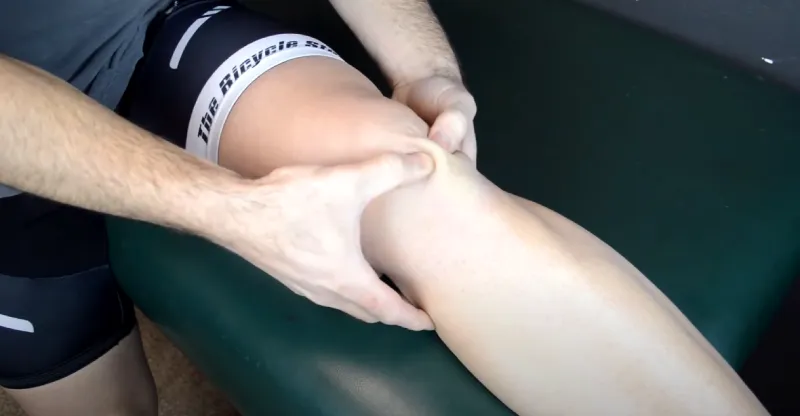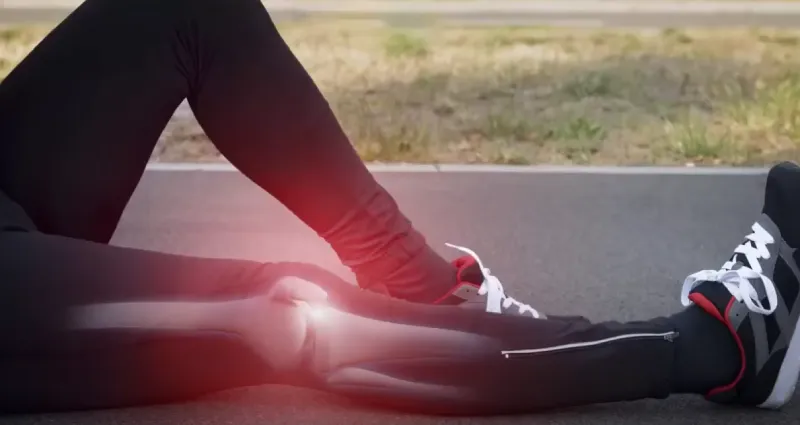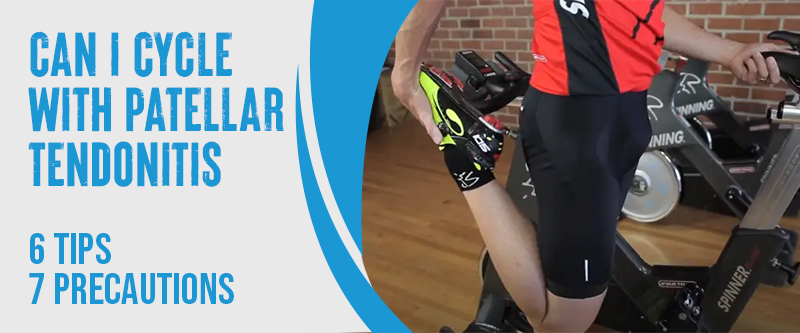The patellar tendon is damaged by repetitive stress on the patellar tendon, which happens when you run, jump, or cycle. Cycling can exacerbate the injury by damaging the tendons, muscles, and ligaments surrounding the knee joint.
The pain and discomfort caused by patellar tendonitis can also affect your performance and make it challenging to complete the activity.
It is not recommended to cycle with patellar tendonitis as it can aggravate the condition and cause further damage to the knee joint. Cycling should be avoided only in the most severe cases.
This blog post will explore how to cycle safely if you have patellar tendonitis and provide tips on prevention, treatment, and symptoms. Find out the best precautions to take for your recovery.
Can I Cycle With Patellar Tendonitis: 4 Treatment Steps

You can cycle with patellar tendonitis, but it should be done carefully to avoid further irritation. Cycling can be a part of the rehab program, as it is a knee-friendly cardio exercise. It’s recommended to prevent sprinting and hills initially to keep the force low. Below are a few precautions to take:
Consult with a Medical Professional
Before you cycle with patellar tendonitis, you should consult a doctor or physical therapist. They can help you assess your condition’s severity and advise on managing it. They may recommend a rest period or specific treatments, such as ice and elevation or physical therapy.
Take Time Off from Cycling to Allow the Tendon to Heal
Patellar tendonitis is usually caused by repeated stress on the patellar tendon. You may need to take some time off from cycling until your tendon heals. Your doctor can advise you on how long you need to rest and when it is safe to cycle again.
Modify Your Training Routine
When you cycle again, change your training routine by reducing your mileage, intensity, and frequency of rides. You can accumulate these factors as your tendon heals. It is important to remember that the goal is to improve your fitness and not to overexert yourself.
Use a Low Resistance and High Cadence
To reduce stress on the knee, ensure that the resistance is low and the cadence is high when cycling. This means using a lighter gear and pedaling faster. This technique will reduce the strain on your patellar tendon and distribute the workload to other muscles.
Wear Properly Fitting Shoes and Pedals
Proper alignment is crucial when biking with patellar tendonitis. Wearing shoes and pedals that fit correctly helps ensure your lower body is in the correct position. This reduces the pressure on the patellar tendon and improves your overall riding experience.
Stretch and Warm Up Properly Before Each Ride
Stretching and warming up properly before each ride is essential for preventing injuries. It prepares your muscles for the workout and improves your flexibility and range of motion. Before cycling, take some time to stretch your quadriceps, hamstrings, and calf muscles.
Incorporate Strength Training Exercises
The strength and stability of your legs can be improved by incorporating strength training exercises for your quadriceps and hamstrings. Sturdy legs reduce the stress on the patellar tendon and support your riding performance.
Patellar Tendonitis: 6 Symptoms
Patellar tendonitis results from overuse of the tendon that connects your kneecap to your shinbone. When you cycle, you repeatedly bend and straighten your knee, stressing the patellar tendon. This can lead to inflammation, weakness, and pain in the knee. Here are some of the most common symptoms of patellar tendonitis:
Pain and Tenderness
Patellar tendonitis can cause pain and tenderness around the patellar tendon below the kneecap. This can be exceptionally bothersome during activities that involve bending or extending the knee joint, such as cycling.
Swelling and Inflammation
When your patellar tendon is swollen, it can make it more challenging to move your knee and put pressure on the patellar tendon. It can also make cycling uncomfortable and painful.
Weakness and Stiffness in the Quadriceps Muscles
Strength or stiffness in the quadriceps muscles, which extend the knee joint, can also contribute to discomfort during cycling. Keeping these muscles strong and flexible is essential to support knee joint health.
Popping or Grinding Sensation
Some individuals with patellar tendonitis may also experience a popping or grinding sensation when they bend or straighten their knees. This can be because of friction between the patellar tendon and the femur (thigh bone), which may be exacerbated during activities like cycling.
Difficulty Walking Up or Down Stairs or Hills
Patellar tendonitis can cause difficulty climbing stairs or hills due to knee joint stress, showing an advanced condition requiring medical attention.
Patellar Tendonitis with Cycle: 5 Causes

As mentioned earlier, patellar tendonitis is commonly caused by over-training, sudden increases in training volume, jumping, overloading the tendon, or poor biomechanics resulting from your bike fit. Here are some causes:
- Over-training: Over-training is one factor that can contribute to patellar tendonitis. Athletes who push themselves too hard in training may develop this condition because of the increased load on the patellar tendon.
- Sudden Increase in Training Volume: An abrupt increase in training volume can also stress the patellar tendon more. Jumping, running, and cycling require repetitive movements that strain the tendon.
- Jumping Activities: Jumping activities like basketball, volleyball, and gymnastics cause patellar tendonitis because they involve high-affected knee movements.
- Overloading the Tendon: Overloading the tendon can happen if you perform exercises correctly or use equipment appropriate for your fitness level. This can cause severe injuries to the patellar tendon.
- Poor Bike Fit: If you cycle with a poor bike fit, your knee may be misaligned when pedaling, leading to additional
stress on the patellar tendon.
Preventing Patellar Tendonitis With Cycling: 6 Tips
Cyclists are susceptible to patellar tendonitis because of the pressure exerted on their knees during cycling. Here are some tips to help prevent patellar tendonitis while cycling.
Increase Volume Gradually
The best prevention strategy for patellar tendonitis is to increase training volume methodically since a rapid increase is one of the leading causes. Increasing your volume by 10 percent weekly is a good idea, but everyone’s different.
ICE
You’ll need rest, ice, compression, and elevation as components of this acronym. This treatment reduces swelling. If your leg is still sore, try icing it thrice daily for 15-20 minutes while elevating it. A compression bandage and taking a break may also be beneficial.
Eccentric Exercises
Some sources suggest eccentric quadriceps exercises may benefit athletes with chronic patellar tendonitis. Any exercise that contracts and lengthens simultaneously is eccentric. An example of an eccentric exercise that would be good for patellar tendonitis would be the lowering phase of a squat.
Stretching
Maintain proper biomechanics and joint movements by stretching your quadriceps, hip flexors, and hamstrings. Ensure you stretch your quads after a ride, like lunges, forward bends, or lying quads.
Avoiding Overuse and Repetitive Activities
Patellar tendonitis occurs due to overuse or repetitive activities, so it is essential to prevent these activities when exercising. This involves avoiding cycling too frequently or for too long and reducing the workout intensity over time rather than making sudden changes.
Listen to Your Body
Your body knows best. A pain signal tells your body something is wrong. Once you acknowledge the pain, you can work to overcome it and pedal pain-free again.
Patellar Tendonitis: 4 Treatment Options
Patellar Tendonitis, commonly known as Jumper’s Knee, occurs in athletes who frequently engage in cycling. It results in pain in the patellar tendon, linking the kneecap to the shinbone. Effective recovery hinges on appropriate treatment and care. Here are some practical approaches for managing Patellar Tendonitis:
Physical Therapy and Rehabilitation

Exercises that promote physical therapy and rehabilitation play a vital role in treating Patellar Tendonitis. Strengthening muscles and improving flexibility around the knee will reduce pain and inflammation. Fitness trainers and physical therapists can create exercise programs based on an individual’s needs. Exercise program according to the individual’s needs and conditions.
Medical Interventions such as Braces and Supports
Braces and supports can provide additional support to the knee joint and help reduce stress on the patellar tendon. These devices can be handy for athletes who must continue training or compete while recovering from Patellar Tendonitis.
Anti-inflammatory Medication
Patients with Patellar Tendonitis may benefit from over-the-counter pain relievers like ibuprofen. However, it is essential to consult a physician before taking these medications and follow the dosage instructions carefully.
Surgery in Severe Cases
Surgery is usually the last resort for Patellar Tendonitis. It is typically only recommended when conservative treatments have significantly failed to improve. The primary surgical procedures for Patellar Tendonitis include removing damaged tissue or repairing the tendon.
Conclusion
Patellar tendonitis can significantly affect the functioning of your knees. However, rest and avoidance of physical activity may not be the best solution. Incorporating low-affected exercise like cycling can help maintain overall fitness while avoiding further damage to the knee.
If you want to cycle with patellar tendonitis, take necessary precautions, such as using proper form, a comfortable saddle, and footwear, and consulting with a doctor or physical therapist before starting. With patience, care, and exercise, you can keep your patellar tendonitis under control while enjoying a ride.
FAQs
How Long Should I Rest Patellar Tendonitis?
Mild tendonitis can be treated within three weeks, and a person can return to normal activities. The recovery process may take three months or longer in more severe cases. The pain in the knee may persist even after a person recovers from patellar tendonitis.
Is Cycling Bad For Patellar Tendonitis?
Yes, cycling can worsen patellar tendonitis due to the overuse of the quadriceps and hip flexor muscles, which increases strain on the patellar tendon. The seated position in cycling may also contribute to shortening these muscle groups, further impacting the condition. When managing patellar tendonitis while cycling, it’s essential to be mindful of these factors.
Is Cycling Good For Patellar Tendonitis?
Cycling may be suitable in the early stages of rehab if pain-free, but it’s not ideal for patellar tendonitis due to challenges in tracking force and time under tension compared to specific tendon exercises.
Is There A Stationary Bike That Can Help With Patellar Tendonitis?
Yes, recumbent stationary bikes are recommended for individuals with patellar tendonitis as they reduce stress on the knee joints. Start with low resistance, avoid high gears, and monitor your knee’s response to prevent overexertion. Consult a healthcare professional before starting to ensure proper usage for recovery.


